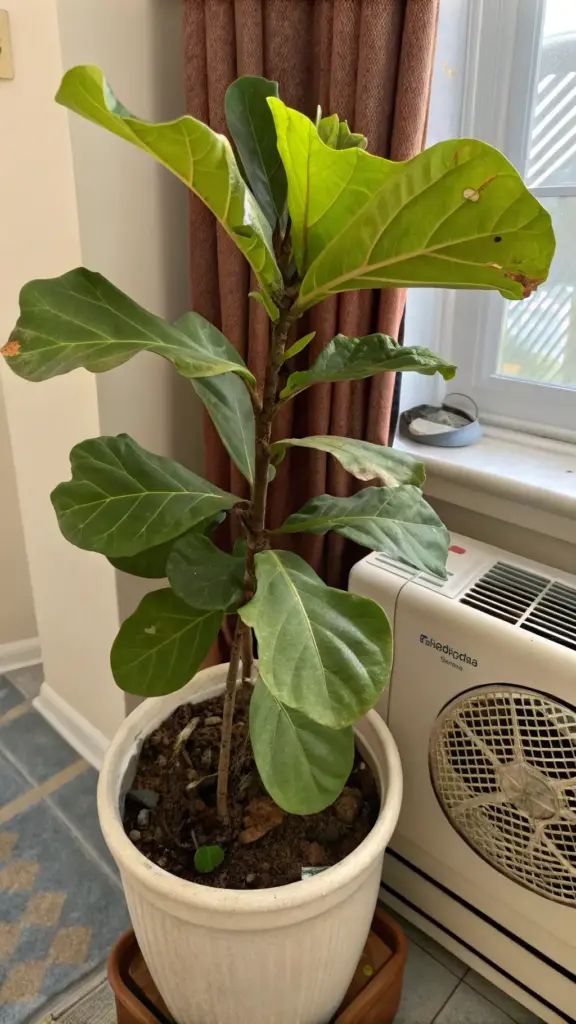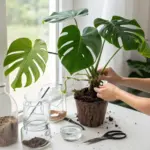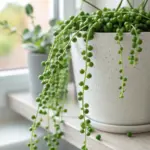5. Environmental Stress is Weakening Your Plant’s Health

I thought I had everything figured out with my fiddle leaf fig care routine. Perfect watering schedule, great lighting, proper humidity – yet my plant still looked stressed and unhappy.
Then I realized my “perfect” plant spot was right next to a heating vent that blasted hot air every time the furnace kicked on. My poor fiddle leaf fig was basically living in a wind tunnel of temperature chaos.
Environmental stress is like the silent killer of houseplants. You can do everything else right, but if your plant’s surroundings are constantly changing, it’ll never truly thrive.
Hidden Stressors Lurking in Your Home
Temperature swings are probably the biggest culprit in most homes. Your fiddle leaf fig wants consistent temps between 65-75°F, not the roller coaster most of us live with.
I used to keep my thermostat at 68°F during the day and 60°F at night to save money. That 8-degree swing was stressing my plant more than I realized.
Air circulation problems can create pockets of stagnant air that promote fungal issues. But too much air movement from fans or vents creates its own set of problems.
Chemical exposure from cleaning products, air fresheners, or even new furniture can slowly poison your plant. Fiddle leaf figs are surprisingly sensitive to airborne chemicals.
Vibrations from heavy foot traffic, slamming doors, or even loud music can stress plants over time. They might not show it immediately, but chronic stress adds up.
Temperature Fluctuations: The Silent Plant Killer
Consistent temperature is way more important than the exact number on your thermostat. A steady 70°F is better than swinging between 65°F and 75°F throughout the day.
I learned this when I moved my plant away from the window during a cold snap. Even though the new spot was “warmer,” the constant temperature changes from the heating system caused massive leaf drop.
Cold drafts are especially brutal for tropical plants. That lovely spot by the front door might have great light, but the cold air every time someone enters will slowly kill your fiddle leaf fig.
Heat sources like radiators, space heaters, or heating vents create hot spots that can literally cook your plant’s leaves. I’ve seen perfectly healthy leaves turn brown overnight from being too close to a heat source.
Watch for seasonal stress when you switch from heating to cooling or vice versa. These transition periods can be rough on sensitive plants.
Battling the HVAC System That Hates Your Plants
Heating vents are plant killers disguised as convenient warm spots. That blast of hot, dry air will dehydrate your fiddle leaf fig faster than you can say “leaf drop.”
I had to get creative with furniture placement to block direct airflow while still allowing my plant to benefit from the general warmth. A strategically placed bookshelf became my plant’s best friend.
Air conditioning creates its own problems with cold drafts and sudden temperature drops. Your plant doesn’t care that you’re comfortable – it just knows the environment keeps changing.
Ceiling fans can be helpful for air circulation, but not if they’re creating a constant breeze directly on your plant. Gentle, indirect air movement is what you’re after.
Consider using a room thermometer near your plant to track actual temperature fluctuations. You might be surprised how much variation there is in different parts of the same room.
Pot Size: Getting the Goldilocks Zone Right
Overpotting is one of the most common mistakes I see new plant parents make. That huge, beautiful pot might look proportional, but your fiddle leaf fig’s roots will be swimming in too much soil.
A pot that’s too large holds too much moisture and can lead to root rot. Your plant should only move up one pot size (about 2 inches wider) when you repot.
Underpotting creates its own stress as roots become cramped and can’t access enough nutrients or water. Signs include water running straight through the pot and roots growing out of drainage holes.
Root-bound plants will show stunted growth, frequent wilting, and may even crack their pots. I’ve had terracotta pots literally split from root pressure.
The ideal pot size allows about 1-2 inches of fresh soil around the existing root ball. Any more than that and you’re asking for trouble.
Soil Mix: The Foundation of Plant Health
Regular potting soil from the garden center is usually too heavy and holds too much moisture for fiddle leaf figs. I killed my first plant with “premium” potting mix that turned into concrete when it dried.
Well-draining soil is absolutely critical. I mix regular potting soil with perlite, bark chips, and a little sand to create better drainage.
The soil should feel light and fluffy, not dense and heavy. When you water, excess should drain out quickly rather than sitting on top or pooling.
pH levels matter too – fiddle leaf figs prefer slightly acidic soil around 6.0-7.0. Most commercial potting mixes are in this range, but it’s worth checking.
Fresh soil provides better nutrition and drainage than old, compacted soil. I repot every 2-3 years even if the pot size doesn’t need to change.
Signs It’s Time to Repot
Water drainage issues are the biggest red flag. If water sits on the surface or runs straight through without being absorbed, your soil is probably shot.
Roots growing out of drainage holes mean your plant has outgrown its current home. Don’t wait until the roots are circling the pot like spaghetti.
Frequent wilting despite proper watering can indicate the soil isn’t holding moisture effectively anymore. Old soil can become hydrophobic and actually repel water.
Salt buildup on the soil surface or pot rim indicates it’s time for fresh soil. Those white crusty deposits are concentrated fertilizer salts that can damage roots.
Slow growth during growing season might mean your plant needs fresh soil with better nutrition and structure.
Creating Your Plant’s Perfect Microenvironment
Consistent placement is key to reducing environmental stress. Once you find a spot that works, resist the urge to keep moving your plant around.
I used to rotate my fiddle leaf fig weekly for “even growth,” but the constant environmental changes were stressing it out more than helping. Now I only turn it slightly every few weeks.
Buffer zones can help protect your plant from environmental extremes. A small side table or plant stand can lift your fiddle leaf fig away from floor drafts.
Monitoring tools like thermometers and humidity meters help you understand what your plant is actually experiencing. The conditions 3 feet off the ground can be very different from what you feel standing up.
Gradual changes are always better than sudden ones. If you need to move your plant or change its environment, do it slowly over several days or weeks.
Conclusion
Your fiddle leaf fig doesn’t have to be a source of frustration anymore! By addressing these five common issues – watering consistency, proper lighting, humidity levels, nutrition, and environmental stability – you’re well on your way to becoming the plant parent you’ve always wanted to be.
Remember, every plant is different, and it might take some time to find the perfect routine. Start with one or two changes, observe how your plant responds, and adjust accordingly.
Your future self (and your thriving fiddle leaf fig) will thank you! Ready to transform your space with a gorgeous, healthy plant?
Begin implementing these solutions today and watch your green baby flourish into the stunning centerpiece it deserves to be.









GIPHY App Key not set. Please check settings